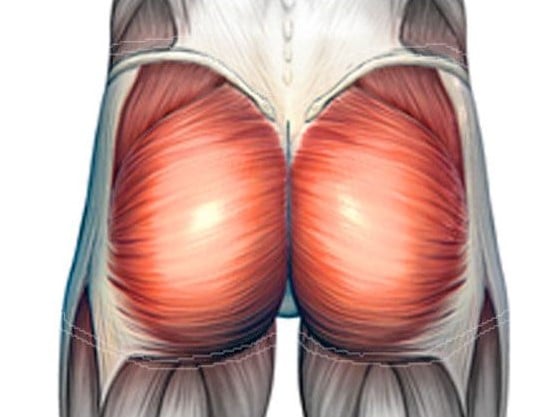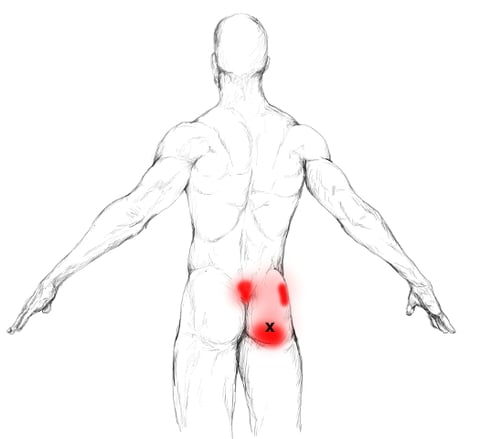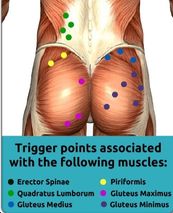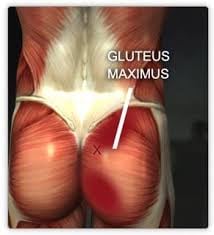THE GLUTEUS MAXIMUS

The gluteus maximus is the outermost and largest of the gluteal muscles, giving the rounded buttock shape. It helps to control lower body movement by maintaining balance through the hip joint and thigh while walking, running, squatting and climbing stairs, contracting to assist with forward movement of the body.
CAUSES:-
It may be difficult to identify the cause the injury as weakness and pain may be present in other areas of the body eg.the back, hip, and knee.
• overuse of the muscle
• poor posture
• trauma
• strenuous exercise where the hamstring is not stretched first – hamstrings are connected to glutes so may be painful with gluteus maximus injury. Weak hamstrings in a runner can cause overstretching and pain of the gluteus maximus, causing legs to give out
• increased risk with activities such as running, walking uphill while leaning forward, repetitive kicking (as seen in martial arts or dancing), weight lifting (for example squats and deadlifts), falling
• pain can result from sciatica originating in the lower back and travelling down the legs via the buttocks
• sitting for prolonged periods eg those who work on computers all day. Chairs may not support the gluteus maximus and surrounding muscles and can encourage poor posture, placing stress on the gluteus maximus while supporting the body.
TYPES OF GLUTEUS MAXIMUS INJURY AND SYMPTOMS:-
1)GLUTEUS MAXIMUS SYNDROME
- spasm or tightness of the muscle which pulls the coccyx and cause pain when moving into or from a sitting position.
- Tenderness or stabbing pain on one side of the buttocks.
- pain stops once in a sitting position but can be reproduced by pressing on the point where the gluteus maximus meets the coccyx
- hip movement may be restricted

2)GLUTEUS MAXIMUS TRIGGER POINT PAIN
- when pain occurs in one of the three trigger points in the muscle. Trigger points are small tight muscle bands found in the muscle which are sore when pressed, causing referred pain in the back of the hip and thigh near the hip joint, the base of the spine, and the upper buttock alongside and into the gluteal fold.
- Pain in the medial trigger - tenderness at the edge of sacrum to gluteal folds or down the back of the thigh
- Pain in the lower trigger - deep tenderness across the entire buttock region causing stabbing pain while sitting
- Pain in the tailbone trigger - pain in the coccyx (tailbone) appears while sitting
- aching pain and stiffness in the outer hip and lower back
- sharp pain when standing after sitting
- burning pain in the buttocks
- uncomfortable and painful sitting
- increased pain when walking uphill and climbing stairs
- inability/increased pain when bending over to touch your toes
Other muscles eg.gluteus medius and minimus, piriformis, iliocostalis and quadratus lumbrorum will exhibit similar symptoms

Trigger points in the gluteus maximus may result in trigger points developing in other muscles such as the gluteus medius and minimus, hamstrings, tensor fascia latae, iliopsoas, pectineus (adductor) and rectus femoris (quad)
CAUSES of Gluteus Maximus Trigger Points:-
• sports involving a lot of jumping
• falling and landing on your backside
• swimming especially when using the flutter kick
• climbing
• deep knee bends
• weightlifting
• repetitive lifting of heavy objects with knees bent (this may protect your back, but puts enormous strain on the glute max)
• prolonged sitting on hard surfaces
• sitting for long periods
• sitting on a wallet
TREATMENT for Gluteus Maximus Trigger Point Pain:-
• physiotherapy
• massage
• heat gel such as Sombra Warm Therapy Gel which relaxes muscles and relieves pain without the burning heat of other gels
• hot and cold packs eg. CorPak Soft Comfort Large Hot & Cold Pack Wrap - ideal for the gluteal muscles, can be used cold to reduce swelling or warm for older injuries or chronic pain to relax the muscles and increase circulation
• a coccyx cushion to relieve pressure and pain in the low back, hips, and thighs when sitting
PREVENTION of Gluteus Maximus Trigger Points:-
• do not sit for hours at a time as it shortens and tightens the muscle. If you work in an office a standing desk may be beneficial
• take your wallet, phone etc out of your back pocket before sitting
• warm up and stretch before exercise
• take breaks when doing climbing or uphill hiking
• don't push past the muscle fatigue if running stairs
• use correct form when lifting weights
3)GLUTEUS MAXIMUS STRAIN

- pulled muscle commonly felt around the tailbone or the near the hip joint when the muscle is stretched past its limit causing tears. The strain can result from strenuous activity or overuse and repetitive motions of the hip.
- pain ranges from sudden and sharp (injury) to dull persistent aching (repetitive motion wear and tear)
- pain is usually sudden and intense near the tailbone or on the outside of the hip
- discomfort with increasing pain on the outer hip or near the gluteal fold (repetitive stress)
- pain when walking, particularly uphill or stairs
- difficulty squatting, sitting down and standing up
- limited range of motion and weakness in the hip
- swelling and bruising
- muscle spasms
CAUSES:-
- failure to warm up properly
- muscle fatigue
- rapid acceleration when running
-walking or running uphill or stairs
- aggressive jumping and lunging
- explosive kicks (martial arts, dancing)
- kicking a ball (football, soccer)
- swimming especially when using the flutter kick
- repetitive lifting of heavy objects
- falling and landing on the buttocks
- contact sports
- deep squats and knee bends
TREATMENT:-
• rest - limit hip movement and weight bearing on the affected side.
• ice - apply ice or cold packs every 2 hours for 20 minutes per treatment the first 24-48 hours. BioFreeze Cold Therapy Gel can be applied after an ice/cold pack treatment to prolong the cold treatment and reduce pain.
• compression - apply pressure to reduce swelling and provide support eg.the NatraCure Hot and Cold Hip Wrap works very well for gluteus maximus pain and has a gel pack which can be chilled for injuries and heated for chronic pain. It also provides compression to the muscle to help relieve pain. The Roxofit Hip Brace provides support and compression to an injured gluteus maximus muscle without the heat.
• Elevation - use pillows to elevate and cushion the hip
• Massage
• Physiotherapy
• Trigger point therapy
RECOVERY:-
• a mild strain (Grade I) - minor tearing of muscle and tendon fibres will heal in 2-4 weeks. There is pain and minimal loss of movement or strength in the muscle
• a moderate (Grade II) - partial tearing of the muscle will usually heal in 4-8 weeks. There is moderate pain with some loss of range of motion and strength. You may limp.
• a severe (Grade III) is a complete tear of the muscle and may require surgery. Grade III tears may take several months to a year to fully heal. There is a complete loss of range of movement and muscle strength and you cannot weight bear on the affected side.
